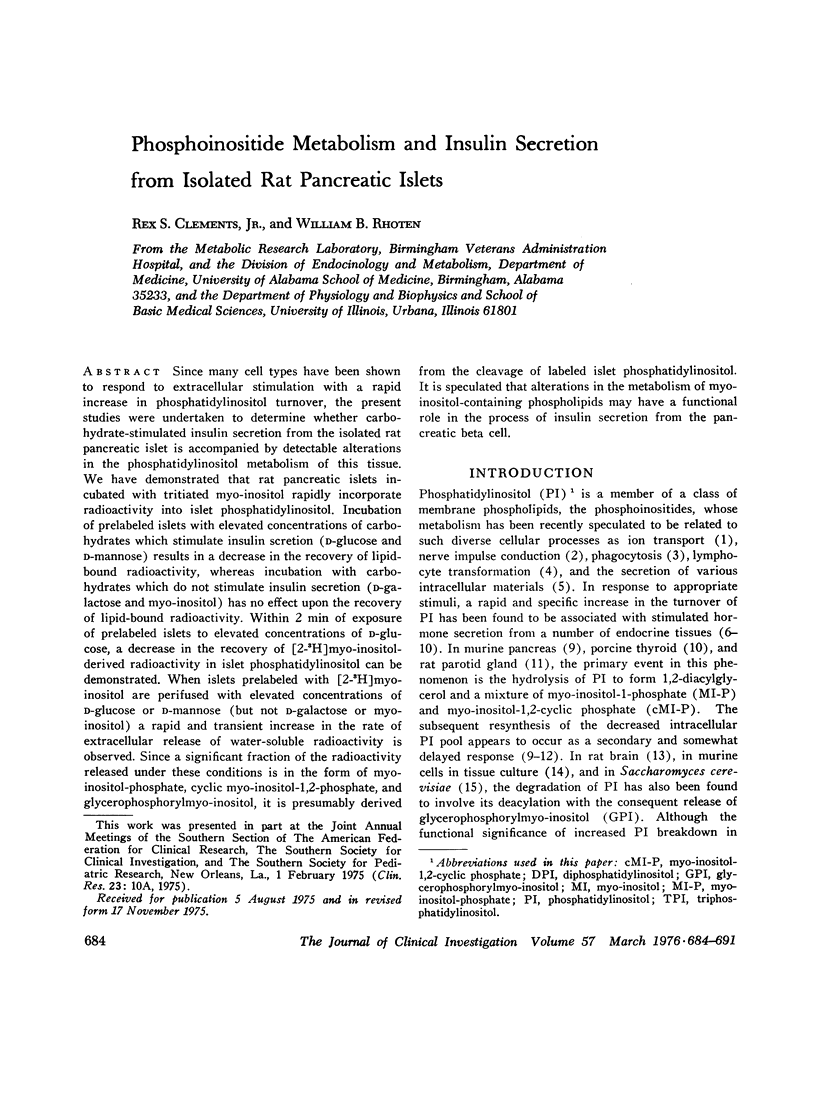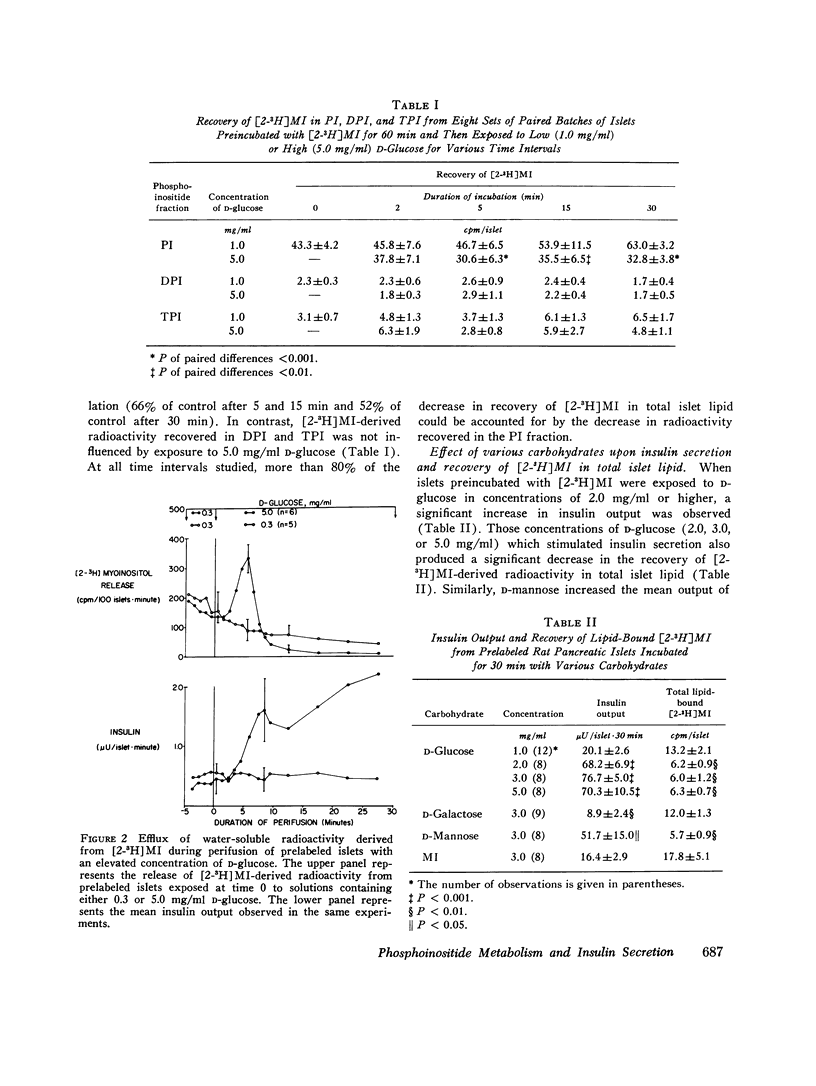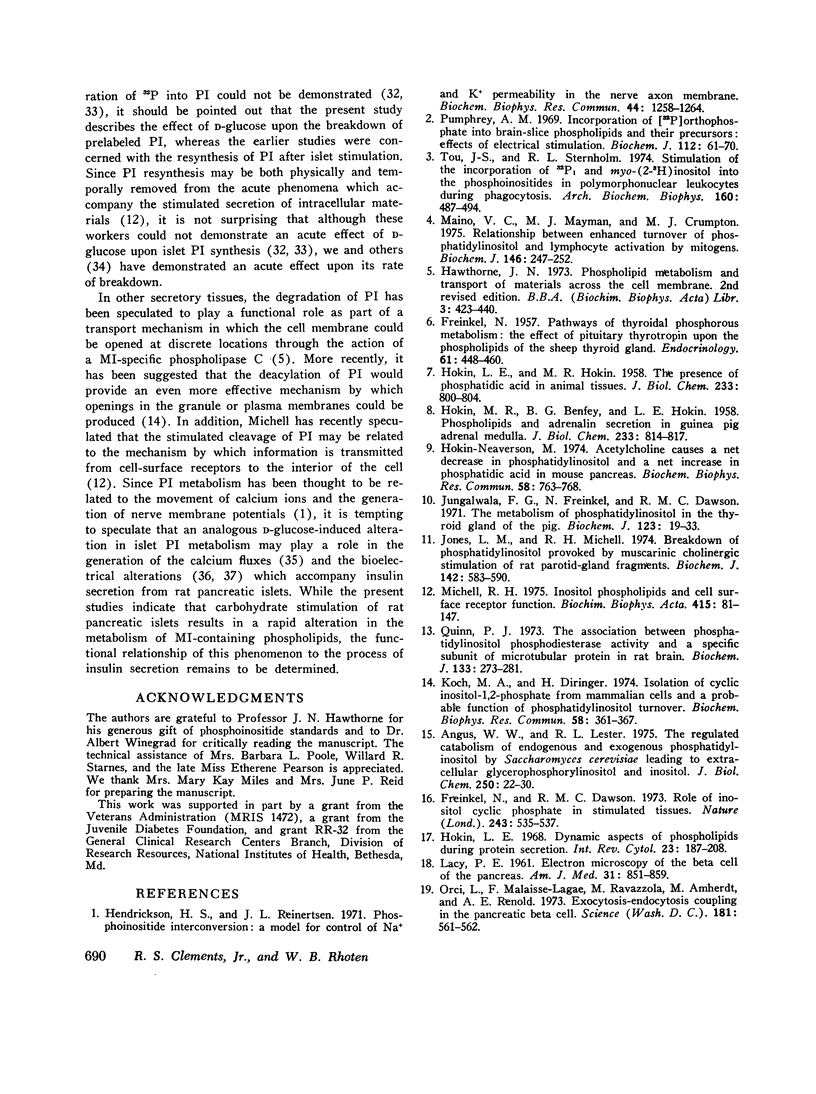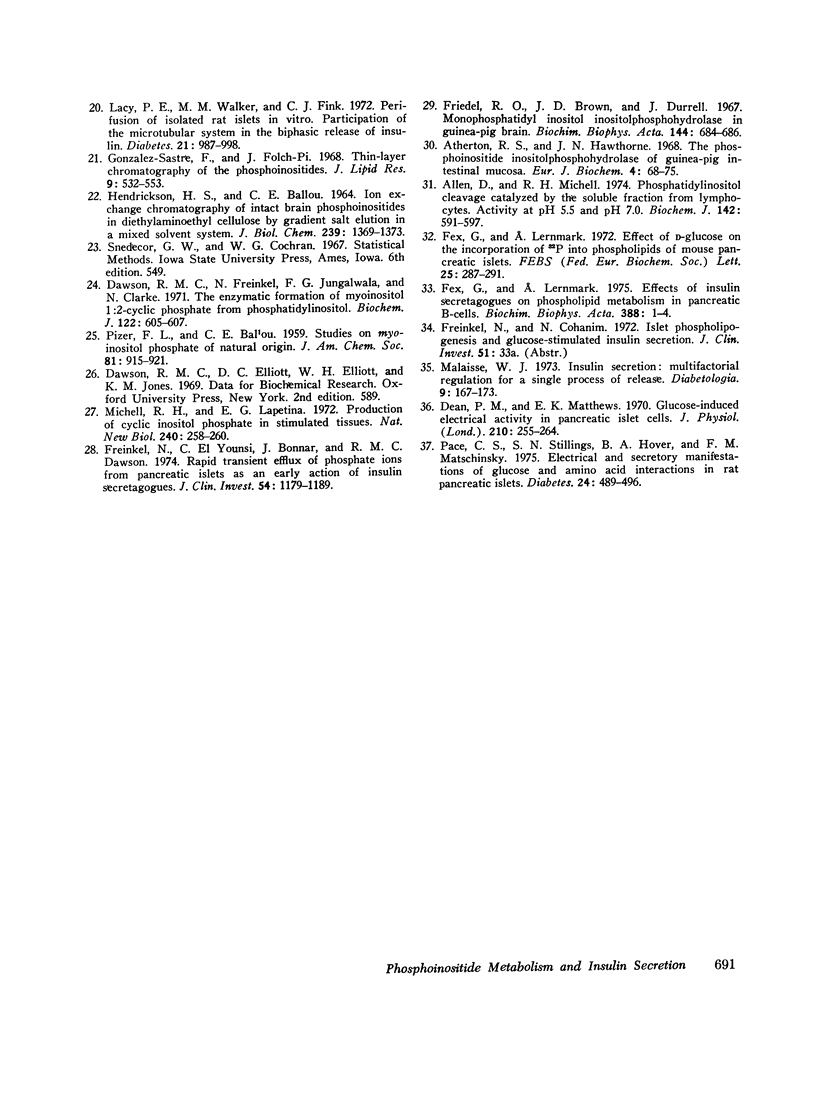Abstract
Since many cell types have been shown to respond to extracellular stimulation with a rapid increase in phosphatidylinositol turnover, the present studies were undertaken to determine whether carbohydrate-stimulated insulin secretion from the isolated rat pancreatic islet is accompanied by detectable alterations in the phosphatidylinositol metabolism of this tissue. We have demonstrated that rat pancreatic islets incubated with tritiated myo-inositol rapidly incorporate radioactivity into islet phosphatidylinositol. Incubation of prelabeled islets with elevated concentrations of carbohydrates which stimulate insulin secretion (D-glucose and D-mannose) results in a decrease in the recovery of lipid-bound radioactivity, whereas incubation with carbohydrates which do not stimulate insulin secretion (D-galactose and myo-inositol) has no effect upon the recovery of lipid-bound radioactivity. Within 2 min of exposure of prelabeled islets to elevated concentrations of D-glucose, a decrease in the recovery of [2-3H]myo-inositol-derived radioactivity in islet phosphatidylinositol can be demonstrated. When islets prelabeled with [2-3H]myo-inositol are perifused with elevated concentrations of D-glucose or D-mannose (but not D-galactose or myoinositol) a rapid and transient increase in the rate of extracellular release of water-soluble radioactivity is observed. Since a significant fraction of the radioactivity released under these conditions is in the form of myo-inositol phosphate, cyclic myo-inositol-1,2-phosphate, and glycerophosphorylmyo-inositol, it is presumably derived from the cleavage of labeled islet phosphatidylinositol. It is speculated that alterations in the metabolism of myo-inositol-containing phospholipids may have a functional role in the process of insulin secretion from the pancreatic beta cell.
Full text
PDF







Selected References
These references are in PubMed. This may not be the complete list of references from this article.
- Allan D., Michell R. H. Phosphatidylinositol cleavage catalysed by the soluble fraction from lymphocytes. Activity at pH5.5 and pH7.0. Biochem J. 1974 Sep;142(3):591–597. doi: 10.1042/bj1420591. [DOI] [PMC free article] [PubMed] [Google Scholar]
- Angus W. W., Lester R. L. The regulated catabolism of endogenous and exogenous phosphatidylinositol by Saccharomyces cerevisiae leading to extracellular glycerophosphorylinositol and inositol. J Biol Chem. 1975 Jan 10;250(1):22–30. [PubMed] [Google Scholar]
- Atherton R. S., Hawthorne J. N. The phosphoinositide inositolphosphohydrolase of guinea-pig intestinal mucosa. Eur J Biochem. 1968 Mar;4(1):68–75. doi: 10.1111/j.1432-1033.1968.tb00173.x. [DOI] [PubMed] [Google Scholar]
- Dawson R. M., Freinkel N., Jungalwala F. B., Clarke N. The enzymic formation of myoinositol 1:2-cyclic phosphate from phosphatidylinositol. Biochem J. 1971 May;122(4):605–607. doi: 10.1042/bj1220605. [DOI] [PMC free article] [PubMed] [Google Scholar]
- Dean P. M., Matthews E. K. Glucose-induced electrical activity in pancreatic islet cells. J Physiol. 1970 Sep;210(2):255–264. doi: 10.1113/jphysiol.1970.sp009207. [DOI] [PMC free article] [PubMed] [Google Scholar]
- FREINKEL N. Pathways of thyroidal phosphorus metabolism: the effect of pituitary thyrotropin upon the phospholipids of the sheep thyroid gland. Endocrinology. 1957 Oct;61(4):448–460. doi: 10.1210/endo-61-4-448. [DOI] [PubMed] [Google Scholar]
- Fex G., Lernmark A. Effect of D-glucose on the incorporation of 32P into phospholipids of mouse pancreatic islets. FEBS Lett. 1972 Sep 15;25(2):287–291. doi: 10.1016/0014-5793(72)80505-2. [DOI] [PubMed] [Google Scholar]
- Fex G., Lernmark A. Effects of insulin secretagogues on phospholipid metabolism in pancreatic beta-cells. Biochim Biophys Acta. 1975 Apr 18;388(1):1–4. doi: 10.1016/0005-2760(75)90055-7. [DOI] [PubMed] [Google Scholar]
- Freinkel N., Dawson R. M. Role of inositol cyclic phosphate in stimulated tissues. Nature. 1973 Jun 29;243(5409):535–537. doi: 10.1038/243535a0. [DOI] [PubMed] [Google Scholar]
- Freinkel N., Younsi C. E., Bonnar J., Dawson R. M. Rapid transient efflux of phosphate ions from pancreatic islets as an early action of insulin secretagogues. J Clin Invest. 1974 Nov;54(5):1179–1189. doi: 10.1172/JCI107861. [DOI] [PMC free article] [PubMed] [Google Scholar]
- Friedel R. O., Brown J. D., Durell Monophosphatidyl inositol inositolphosphohydrolase in guinea-pig brain. Biochim Biophys Acta. 1967 Dec 5;144(3):684–686. doi: 10.1016/0005-2760(67)90059-8. [DOI] [PubMed] [Google Scholar]
- Gonzalez-Sastre F., Folch-Pi J. Thin-layer chromatography of the phosphoinositides. J Lipid Res. 1968 Jul;9(4):532–533. [PubMed] [Google Scholar]
- HENDRICKSON H. S., BALLOU C. E. ION EXCHANGE CHROMATOGRAPHY OF INTACT BRAIN PHOSPHOINOSITIDES ON DIETHYLAMINOETHYL CELLULOSE BY GRADIENT SALT ELUTION IN A MIXED SOLVENT SYSTEM. J Biol Chem. 1964 May;239:1369–1373. [PubMed] [Google Scholar]
- HOKIN L. E., HOKIN M. R. The presence of phosphatidic acid in animal tissues. J Biol Chem. 1958 Oct;233(4):800–804. [PubMed] [Google Scholar]
- HOKIN M. R., BENFEY B. G., HOKIN L. E. Phospholipides and adrenaline secretion in guinea pig adrenal medulla. J Biol Chem. 1958 Oct;233(4):814–817. [PubMed] [Google Scholar]
- Hendrickson H. S., Reinertsen J. L. Phosphoinositide interconversion: a model for control of Na + and K + permeability in the nerve axon membrane. Biochem Biophys Res Commun. 1971 Sep;44(5):1258–1264. doi: 10.1016/s0006-291x(71)80221-8. [DOI] [PubMed] [Google Scholar]
- Hokin-Neaverson M. Acetylcholine causes a net decrease in phosphatidylinositol and a net increase in phosphatidic acid in mouse pancreas. Biochem Biophys Res Commun. 1974 Jun 4;58(3):763–768. doi: 10.1016/s0006-291x(74)80483-3. [DOI] [PubMed] [Google Scholar]
- Hokin L. E. Dynamic aspects of phospholipids during protein secretion. Int Rev Cytol. 1968;23:187–208. doi: 10.1016/s0074-7696(08)60272-7. [DOI] [PubMed] [Google Scholar]
- Jones L. M., Michell R. H. Breakdown of phosphatidylinositol provoked by muscarinic cholinergic stimulation of rat parotid-gland fragments. Biochem J. 1974 Sep;142(3):583–590. doi: 10.1042/bj1420583. [DOI] [PMC free article] [PubMed] [Google Scholar]
- Jungalwala F. B., Freinkel N., Dawson R. M. The metabolism of phosphatidylinositol in the thyroid gland of the pig. Biochem J. 1971 Jun;123(1):19–33. doi: 10.1042/bj1230019. [DOI] [PMC free article] [PubMed] [Google Scholar]
- Koch M. A., Diringer H. Isolation of cyclic inositol-1,2-phosphate from mammalian cells and a probable function of phosphatidylinositol turnover. Biochem Biophys Res Commun. 1974 May 20;58(2):361–367. doi: 10.1016/0006-291x(74)90373-8. [DOI] [PubMed] [Google Scholar]
- LACY P. E. Electron microscopy of the beta cell of the pancreas. Am J Med. 1961 Dec;31:851–859. doi: 10.1016/0002-9343(61)90024-9. [DOI] [PubMed] [Google Scholar]
- Lacy P. E., Walker M. M., Fink C. J. Perifusion of isolated rat islets in vitro. Participation of the microtubular system in the biphasic release of insulin. Diabetes. 1972 Oct;21(10):987–998. doi: 10.2337/diab.21.10.987. [DOI] [PubMed] [Google Scholar]
- Maino V. C., Hayman M. J., Crumpton M. J. Relationship between enhanced turnover of phosphatidylinositol and lymphocyte activation by mitogens. Biochem J. 1975 Jan;146(1):247–252. doi: 10.1042/bj1460247. [DOI] [PMC free article] [PubMed] [Google Scholar]
- Malaisse W. J. Insulin secretion: multifactorial regulation for a single process of release. The Minkowski award lecture delivered on September 7, 1972 before the European Association for the study of Diabetes at Madrid, Spain. Diabetologia. 1973 Jun;9(3):167–173. doi: 10.1007/BF01219778. [DOI] [PubMed] [Google Scholar]
- Michell R. H. Inositol phospholipids and cell surface receptor function. Biochim Biophys Acta. 1975 Mar 25;415(1):81–47. doi: 10.1016/0304-4157(75)90017-9. [DOI] [PubMed] [Google Scholar]
- Michell R. H., Lapetina E. G. Production of cyclic inositol phosphate in stimulated tissues. Nat New Biol. 1972 Dec 27;240(104):258–260. doi: 10.1038/newbio240258a0. [DOI] [PubMed] [Google Scholar]
- Orci L., Malaisse-Lagae F., Ravazzola M., Amherdt M., Renold A. E. Exocytosis-endocytosis coupling in the pancreatic beta cell. Science. 1973 Aug 10;181(4099):561–562. doi: 10.1126/science.181.4099.561. [DOI] [PubMed] [Google Scholar]
- Pace C. S., Stillings S. N., Hover B. A., Matschinsky F. M. Electrical and secretory manifestations of glucose and amino acid interactions in rat pancreatic islets. Diabetes. 1975 May;24(5):489–496. doi: 10.2337/diab.24.5.489. [DOI] [PubMed] [Google Scholar]
- Pumphrey A. M. Incorporation of [32P]orthophosphate into brain-slice phospholipids and their precursors. Effects of electrical stimulation. Biochem J. 1969 Mar;112(1):61–70. doi: 10.1042/bj1120061. [DOI] [PMC free article] [PubMed] [Google Scholar]
- Quinn P. J. The association between phosphatidylinositol phosphodiesterase activity and a specific subunit of microtubular protein in rat brain. Biochem J. 1973 Jun;133(2):273–281. doi: 10.1042/bj1330273. [DOI] [PMC free article] [PubMed] [Google Scholar]
- Tou J. S., Stjernholm R. L. Stimulation of the incorporation of 32Pi and myo-(2-3H)inositol into the phosphoinositides in polymorphonuclear leukocytes during phagocytosis. Arch Biochem Biophys. 1974 Feb;160(2):487–494. doi: 10.1016/0003-9861(74)90425-1. [DOI] [PubMed] [Google Scholar]


